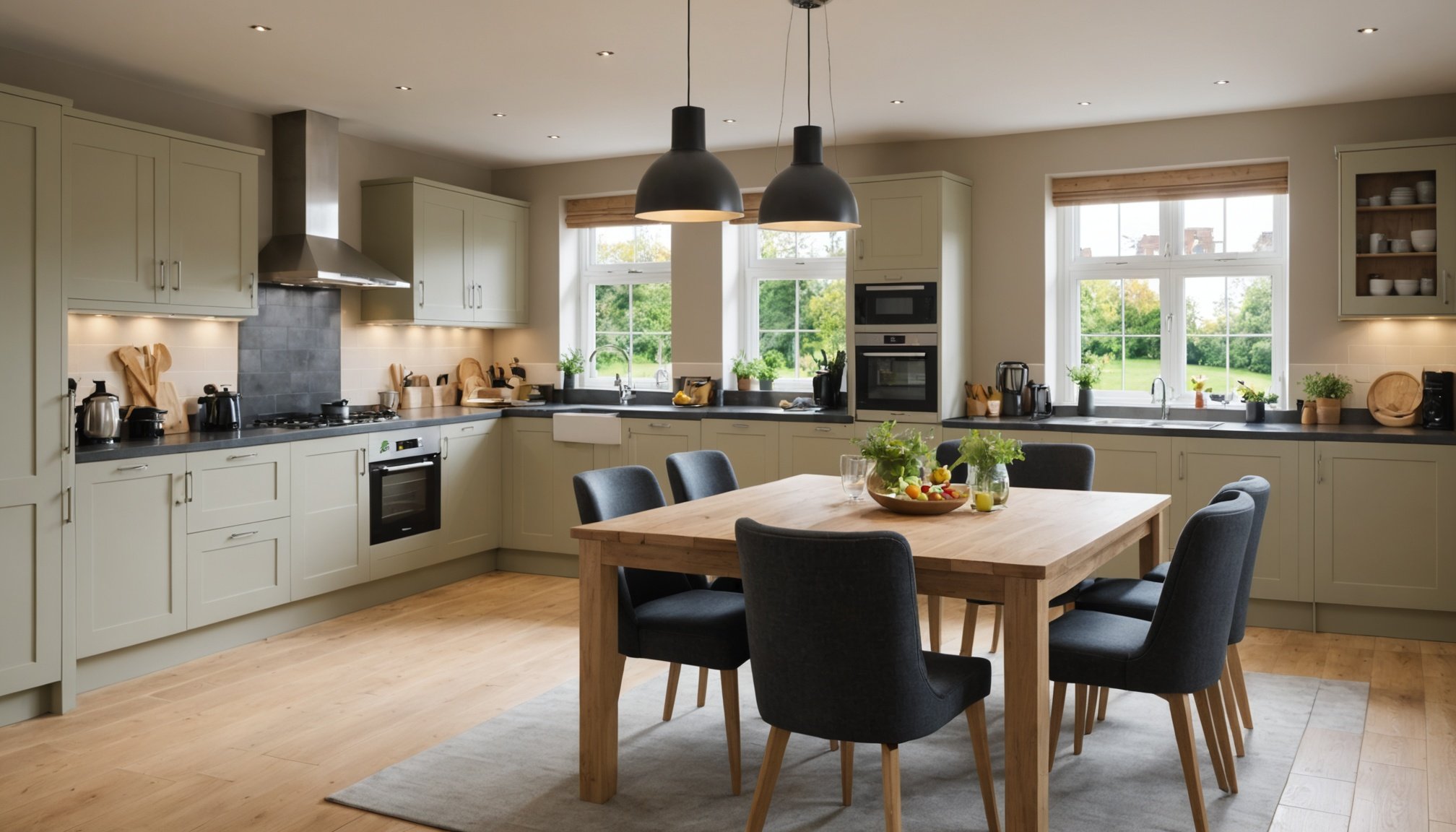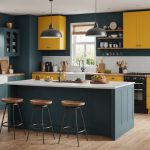Creating a seamless flow between your kitchen and dining area can transform your home into a harmonious and functional space. In the context of UK homes, where space can often be limited, this integration not only enhances aesthetic appeal but also optimizes usability. Whether you’re planning an open-plan design or simply wish to improve connectivity, striking the right balance is essential. This guide will explore practical tips and design insights to help you achieve a cohesive kitchen and dining area that complements your lifestyle.
Understanding the Benefits of an Open-Plan Design
An open-plan design is more than just a trend—it’s a lifestyle choice that reflects modern living. By removing barriers between your kitchen and dining space, you create a versatile environment that promotes social interaction and facilitates multitasking.
In parallel : What are the most common mistakes to avoid when remodeling a UK kitchen?
Enhanced Social Interaction
Having an open space allows family members and guests to interact more freely. Whether cooking for a gathering or overseeing homework while preparing meals, this layout fosters communication and connection. The removal of walls invites a sense of togetherness, making your home feel more inviting.
Increased Natural Light
Particularly in UK homes, where natural light can often be limited, an open-plan design maximizes daylight penetration. With fewer obstructions, light can flow freely through the space, creating a brighter and more welcoming environment.
Also to discover : How can I select the best color palette for my UK kitchen for a harmonious look?
Improved Functionality and Flexibility
An open-plan kitchen and dining area provide flexibility in how space is used. Whether hosting a dinner party or having a family breakfast, an open layout can accommodate different activities without the need for extensive rearrangement. This adaptability makes your home more efficient and comfortable.
Design Cohesion
When your kitchen and dining area share the same space, achieving a cohesive aesthetic becomes easier. By using complementary materials, colors, and styles, you can create a unified look that elevates your home’s overall design.
Design Tips for a Harmonious Kitchen-Dining Area
Merging the kitchen and dining area involves more than just knocking down walls. It requires thoughtful design decisions that seamlessly blend functionality with aesthetics.
Choose a Consistent Color Palette
The use of a consistent color palette is key to ensuring continuity between spaces. Opt for neutral or muted tones that reflect the natural light, creating a cohesive and calming environment. Accent colors can be introduced through accessories or artwork to add interest without overwhelming the space.
Optimize Layout for Flow
The layout is crucial to creating a seamless transition between areas. Consider the movement paths when designing your space. An L-shaped or galley kitchen can offer practicality while maintaining an open feel. Ensure there’s a clear path for movement from the kitchen to the dining table.
Incorporate Multi-Functional Furniture
Invest in furniture that serves multiple purposes. A kitchen island can double as a dining table or a breakfast bar, providing additional seating and workspace. Choose dining chairs that complement your kitchen stools for visual unity.
Utilize Consistent Materials
Use similar materials throughout both areas to enhance the sense of continuity. Whether it’s matching countertops and dining tables or using similar flooring, this consistency ties the spaces together. Wood, stone, and metal are popular choices that add texture and depth.
Add Personal Touches
Incorporating personal elements, such as family photos or cherished items, can make the space feel uniquely yours. These touches personalize the environment, adding warmth and character to the seamless flow.
Lighting Solutions to Enhance Ambiance and Functionality
The right lighting can significantly influence the ambiance and functionality of your integrated kitchen and dining area. Strategically placed fixtures not only illuminate but also define each space’s role.
Layered Lighting Approach
Incorporate a combination of ambient, task, and accent lighting to create a balanced and inviting atmosphere. Ambient lighting provides general illumination, while task lighting ensures functionality in areas like the kitchen counter. Accent lighting can highlight architectural features or artwork.
Pendant and Track Lighting
Pendant lights are an excellent choice over dining tables or kitchen islands, adding both style and focused light. Track lighting can be adjusted to suit different activities and is ideal for illuminating specific areas without cluttering the ceiling.
Natural Light Maximization
Maximizing natural light enhances the open feel of the space. Use sheer curtains or blinds that allow light to filter through while maintaining privacy. Mirrors or reflective surfaces can also help to bounce light around the room.
Dimmable Controls
Installing dimmable lighting gives you control over the mood. Bright lighting for meal prep or a softer glow for dining creates a versatile environment. This flexibility allows you to adapt the space to different times of day and activities.
Positioning for Impact
Strategically position lighting to define zones within the open-plan area. For example, overhead lights in the dining area can create a focal point, while under-cabinet lighting in the kitchen adds functionality and ambiance.
Overcoming Challenges of Limited Space
Many UK homes face the challenge of limited space, especially in urban areas where maximizing every square inch is crucial. Even small kitchens and dining areas can benefit from clever design strategies.
Smart Storage Solutions
Effective storage solutions can make a significant difference in how space is perceived and used. Consider built-in cabinetry, wall-mounted shelves, or overhead racks to keep surfaces clutter-free. Hidden storage solutions, like pull-out pantries or under-bench drawers, can be practical and stylish.
Scale and Proportion
Choose furniture and fixtures that suit the scale of your space. Opt for compact, multi-functional pieces that don’t overwhelm the room. Extendable dining tables or foldable chairs can be stowed away when not in use, maximizing space efficiency.
Creating Zones with Rugs or Flooring
Use rugs or different flooring materials to subtly define spaces without the need for walls. A textured rug under the dining table can visually separate it from the kitchen area. Similarly, contrasting flooring can delineate zones while maintaining an open feel.
Mirrors and Reflective Surfaces
Mirrors can create the illusion of more space by reflecting light and views. Strategically placed mirrors can make a room feel larger and more open. Reflective surfaces like glass or high-gloss finishes amplify light and openness, making cramped areas feel more expansive.
Embrace Vertical Space
Don’t forget to make use of vertical space for storage or decorative elements. Tall shelving units or hanging pots and pans can draw the eye upward, emphasizing height and freeing up floor space.
Integrating your kitchen and dining area into a seamless, open-plan space offers numerous benefits, from improved functionality to enhanced aesthetics. By thoughtfully considering layout, design elements, and lighting, you can create a harmonious environment suited to modern living. Whether you have a sprawling suburban house or a cozy urban flat, these strategies can be tailored to fit your specific needs and preferences. As you embark on this transformation, remember that the key to a successful redesign lies in maintaining a balance between practicality and style, ensuring that your home remains a welcoming, adaptable space for all to enjoy.











